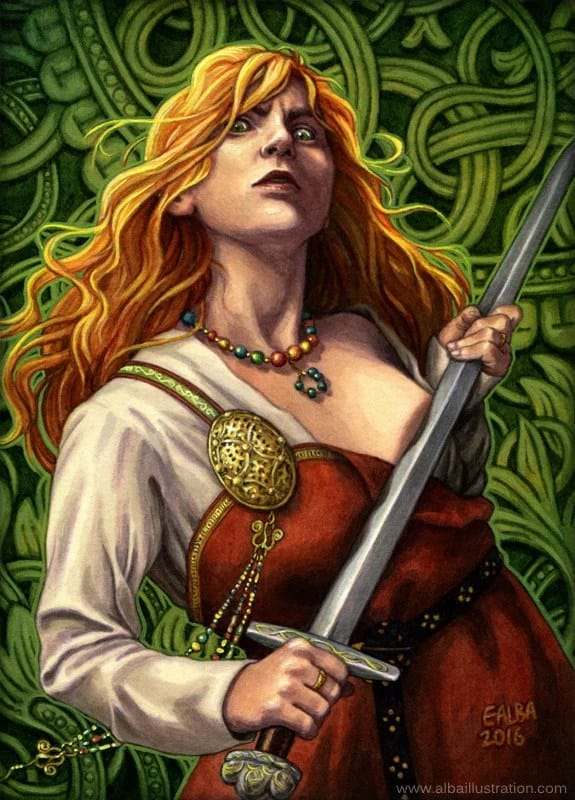In the chronicles of Viking history, the intriguing Freydís Eiríksdóttir stands out. Her tale, a captivating fusion of history and legend, has captivated researchers, historians, and storytellers for centuries. As we delve into the labyrinth of tales and uncertainties surrounding her, prepare to be drawn into the enigmatic world of this legendary Viking explorer and warrior.
Unveiling the Enigmatic Legacy of Freydís Eiríksdóttir
Freydís Eiríksdóttir – her name alone evokes images of fierce Viking raids and daring voyages across the icy Atlantic. As the daughter of Erik the Red, the man credited with discovering Greenland, Freydís is a figure shrouded in mystery. Her story is a captivating blend of history and legend, passed down through generations like a flickering flame in the vast darkness of time.
But who was this woman who sailed from the icy fjords of Scandinavia to the shores of North America nearly a thousand years ago? Was she a fearless warrior, a shield-maiden defending her people against all odds? Or was she a ruthless and ambitious figure, driven by greed and a lust for power?
To unravel the truth of Freydís, we must journey back to a world dictated by oral tradition, where history was woven into epic tales known as sagas. Two Icelandic sagas, “The Saga of Erik the Red” and “The Saga of the Greenlanders,” offer glimpses into her life, each painting a strikingly different portrait. Imagine these sagas as echoes of the past, each storyteller adding their own interpretation, their own embellishments to the narrative.
Both sagas agree that Freydís joined expeditions to Vinland, the Viking name for North America. Picture the hardships she likely endured: perilous ocean crossings, fierce storms, and the challenges of establishing a foothold in a strange new land. But it’s here that the stories diverge.
“The Saga of the Greenlanders” suggests Freydís was as cunning as she was courageous. It hints at a darker side, accusing her of orchestrating a brutal attack on Native American traders and even claiming she had her companions’ wives killed to claim their belongings!
“The Saga of Erik the Red,” however, offers a more heroic perspective. It portrays Freydís as a strong and brave leader. Imagine this: facing an attack while pregnant, she fearlessly rallied her people to fight back, even beating her chest with a sword to scare off their enemies! This act alone speaks volumes about her character.
So, which version of Freydís is closer to the truth? Was she a ruthless opportunist driven by greed or a powerful woman navigating a man’s world, forced to make impossible choices to survive and protect her own?
Adding to the puzzle, we have no definitive archeological evidence to fully corroborate Freydís’s adventures. While the discovery of Viking settlements in North America confirms the voyages described in the sagas, pinpointing Freydís’s exact role remains a tantalizing puzzle.
What Made Freydis Eiriksdottir Famous?
Freydis Eiriksdottir wasn’t just any Viking; she was the daughter of Erik the Red, a name that echoed through the ages. This family connection thrust her into the heart of Viking exploration, particularly the daring voyages to Vinland, a land believed to be the coastline of North America.
What truly makes Freydis’s story stand out are the stark contrasts presented in the two Icelandic sagas that chronicle her life. These sagas, passed down through generations, offer conflicting accounts of her character and actions.
“The Saga of the Greenlanders” casts a dark shadow on Freydis, portraying her as cunning and ruthless. This saga suggests she was involved in a massacre of Native American traders and even went so far as to have her companions’ wives killed to hoard their belongings.
However, “The Saga of Erik the Red” paints a different picture, showcasing Freydis as a strong, even heroic leader. It recounts how, facing an attack while pregnant, she fearlessly rallied her people, going to the extreme of beating her chest with a sword to intimidate their attackers!
This stark difference in portrayal makes it incredibly difficult to pinpoint the “real” Freydis. Was she a power-hungry manipulator driven by greed, or was she a woman forced to make difficult decisions in a world dominated by men? The debate continues to this day, making her one of the most fascinating and enigmatic figures in Viking history.
Regardless of which side of the debate you find more convincing, Freydis’s story provides a unique window into the Viking world. It shows us that Viking women were far from passive bystanders. They could be leaders, warriors, and explorers, taking an active role in shaping their destiny.
Freydis’s story serves as a reminder that exploration, even for seasoned Vikings, was fraught with danger, conflict, and moral ambiguity. The fact that we’re still talking about Freydis centuries later proves that the Viking age, with its larger-than-life characters and daring voyages, continues to capture our imaginations. Her story, full of contradictions and open to interpretation, encourages us to grapple with the complexities of the past and recognize the enduring power of human resilience.
Did Freydis Eriksdottir Have Children?
The sagas tell us of Freydis Eiriksdottir’s daring voyages to Vinland, but they remain silent on a question that continues to intrigue historians and fuel speculation: did she have any children?
The two main sources of information about Freydis, “The Saga of the Greenlanders” and “The Saga of Erik the Red,” don’t mention her having any offspring. This lack of evidence, however, doesn’t definitively rule out the possibility.
Consider this: Viking explorers often embarked on long journeys and established families in the new lands they discovered. It’s certainly possible, even probable, that Freydis might have done the same during her time in Vinland.
Adding to the intrigue, popular culture has embraced the idea of Freydis as a mother. The Netflix series “Vikings: Valhalla” portrays her with a child, a fictional embellishment that has sparked renewed interest in her potential descendants.
To fully grasp the likelihood of Freydis being a mother, it’s essential to consider the roles women played in Viking society, especially during explorations. What challenges and opportunities did they face? How might motherhood have shaped Freydis’s experiences and choices during her voyages?
While the sagas may not offer concrete answers, the lack of evidence hasn’t deterred historians and researchers. Archaeological digs and DNA analysis hold the potential to uncover information about Freydis’s possible descendants, giving us a more tangible link to her life beyond the stories passed down through generations.
What Became of Freydis?
The sagas provide glimpses into Freydis Eiríksdóttir’s life and adventures in Vinland, but her ultimate fate remains shrouded in mystery. Did she embark on further explorations, did she seek a quieter life, or did fate intervene, cutting her story short?
Some historians speculate that Freydis might have met an untimely end during her return voyage from Vinland. The North Atlantic, known for its unpredictable fury, posed significant dangers even to experienced sailors. Storms, illness, or even simple misfortune could have easily brought her journey to a tragic end.
However, Freydis was no stranger to danger. She was a woman who stared down adversity with unwavering courage. It’s entirely plausible that she returned to Greenland or even Iceland, where she might have chosen to settle down, perhaps starting a family or continuing her explorations closer to home.
And then there’s the possibility, however improbable, that Vinland, the land that had been the backdrop for so much of her story, became her final resting place. Could Freydis, with her unyielding spirit and thirst for adventure, have chosen to remain in this new world, forging a new life for herself amidst its untamed beauty and untold perils?
The sagas, unfortunately, offer no definitive answers. Each historian seems to have their own theory, but without concrete evidence, these theories remain just that: speculation. Perhaps one day, a new discovery will come to light, shedding light on the mystery of Freydis’s fate. Until then, her story remains a tantalizing blend of historical fact and imaginative possibility.
If you’d like to explore other captivating figures from history, consider delving into the lives of the most famous samurai in Japanese history. Or perhaps you’d be drawn to the mystery surrounding London’s infamous serial killer, Jack the Ripper, and the investigation into Francis Tumblety and other suspects.
- Unveiling Bernhard Caesar Einstein’s Scientific Achievements: A Legacy in Engineering - July 15, 2025
- Uncover who is Jerry McSorley: CEO, Family Man, Business Success Story - July 15, 2025
- Discover Bernhard Caesar Einstein’s Scientific Contributions: Unveiling a Legacy Beyond Einstein - July 15, 2025
















2 thoughts on “Freydís Eiríksdóttir: Viking Warrior or Saga Myth? Unraveling the Truth of a Vinland Pioneer”
Comments are closed.